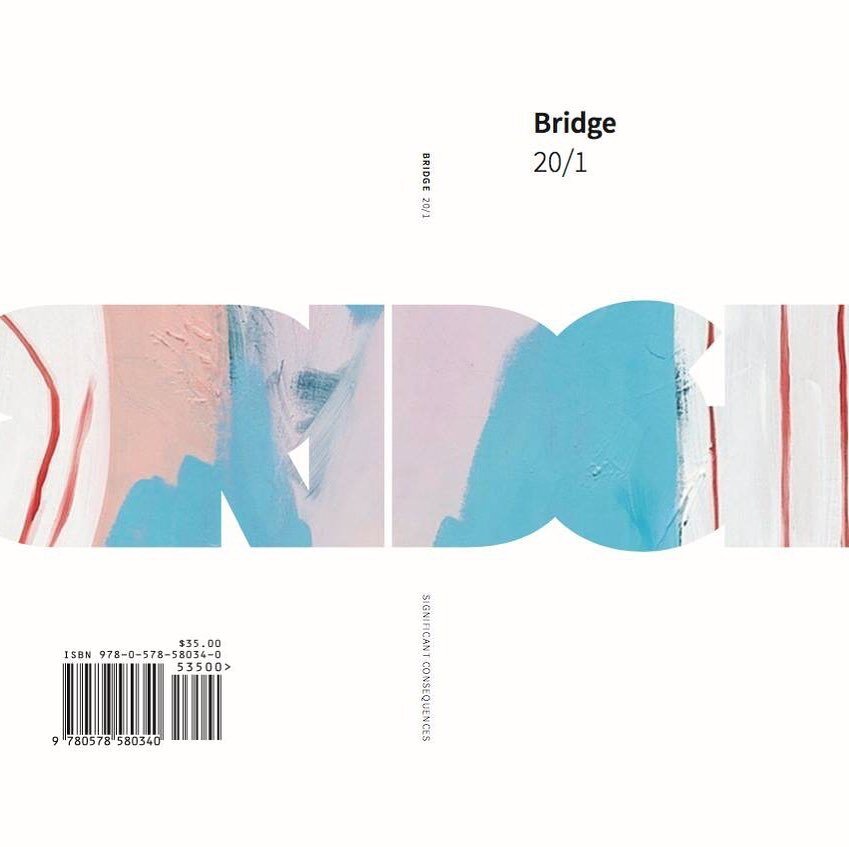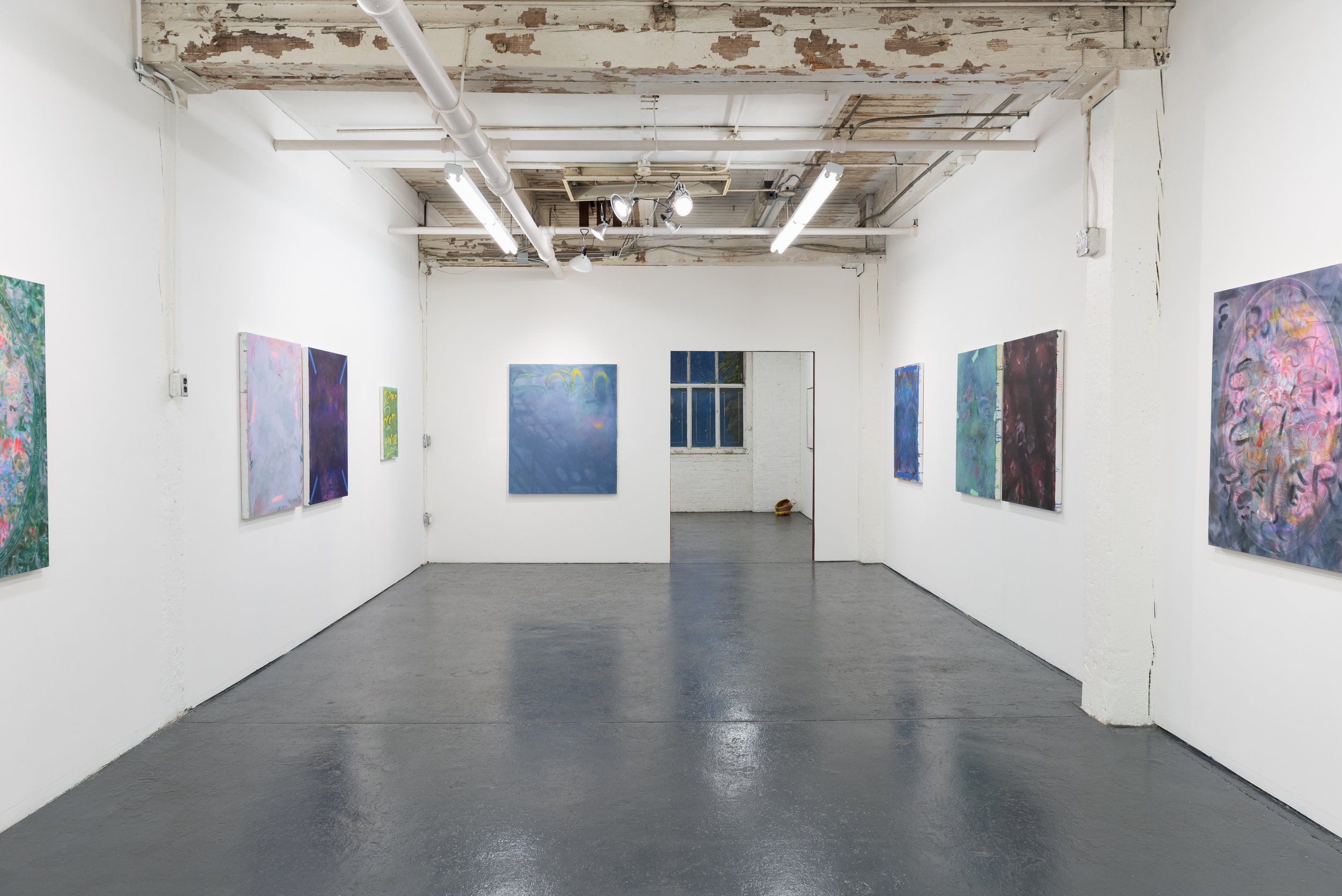REVIEW: Madeline Gallucci, “sound of my father singing” at Goldfinch
Installation view of Madeline Gallucci’s “sound of my father singing” at Goldfinch. Photos by Ryan Edmund.
REVIEW
Madeline Gallucci: sound of my father singing
Goldfinch
319 N. Albany Ave
Chicago IL 60612
November 4, 2023—December 16, 2023
By Annette LePique
In Douglas Sirk’s 1955 All that Heaven Allows, Jane Wyman plays a lonely middle-aged widow whose isolated existence is upended upon the appearance and romantic pursuit of her younger arborist, played by Rock Hudson. Audiences are introduced to Cary Scott (Wyman) as a woman who has spent the majority of her life pleasing those around her: whether that be her deceased first husband, her now grown children, or the other members of her elitist WASP community.
Throughout the film, Sirk reveals glimpses of Cary’s changing inner life through vanity mirrors, window panes, and the sheen of electronic screens. Viewers rarely see a close-up of Wyman’s face shot straight on; rather there are glimpses, hints, and wavering smiles caught through frosted reflections. A friction exists here, a thousand unknown memories and past lives. What is it that we can see in Sirk’s film and what does this vision allow us to truly know about Cary?
Installation view of Madeline Gallucci’s “sound of my father singing” at Goldfinch. Photos by Ryan Edmund. Pictured (left to right): “Miss, 2023,” acrylic on canvas, 30 x 40 x 1 1/2 inches, 76.2 x 101.6 x 3.8 cm and “Mirror (Lover’s Woods),” 2022 acrylic and oil on canvas 30 x 40 x 1 1/2 inches 76.2 x 101.6 x 3.8 cm.
The mirror is then a watch tower, a waypoint, a visual codex from which to begin to untangle the cacophony of noise and color that surrounds us. Yet, because these translations are tenuous at best, what can we see and what do we truly know? It’s this tension that has long held fascination for artist Madeline Gallucci, whose exhibition sound of my father singing, up at Goldfinch Gallery, thinks through the consequences of light, color, and line upon reflecting pools of glass, metal, and dark water. What do these mirrors see when we’re not there?
Gallucci cites filmmaker Douglas Sirk in the show’s written materials as an influence in her own interrogation of the relationship between space and image. While there is a clear through line between how Gallucci and Sirk sculpt space, with mirrors and windows or their two-dimensional counterparts complicating one’s field of vision, Gallucci’s use of color reminds me too of Sirk’s melodramas. Vivid technicolor became a hallmark of the melodramas originally dismissed as “women’s weepies”, the heightened emotions that played out against lush, jewel box textures and interiors were regularly belittled by critics. However, against the over the top tears, turbulence, and passionate embraces that occurred within those perfectly decorate stages there was an unnamed buzzing, a friction, a tension that just won’t leave the eye. For isn’t there something familiar in Jane Wyman’s distress, her despair, her final happy homecoming?
It is this possibility of recognition, of looking so closely that you find an inkling of yourself, an inkling of the unexpected, that hangs upon the exhibition’s contours like a tinseled crown. singing features fifteen sizeable canvases, between two to four feet, with acrylics and oils born of colors that flash upon the insides of eyelids and strike through chlorinated water like diamond blades. Faint auras of mirror edges, coupe glasses, and pool depths haunt the show; with colored painter’s tape guiding the eye, and adding texture, to focal points that disappear in smoke and fog. In conversation with writer and curator Elizabeth Lalley, Gallucci speaks about a pedestrian tunnel under Lakeshore Drive that transforms with each city cleaning; the tags and drawings that embellish the bricks, laced with spider webs, vibrate with their own alien life. The space is presented as a spiritual twin to the artist’s own practice of mark-making, the faint outlines of letters and doodles buzzing against the fields of color that saturate each canvas.
Installation view of Madeline Gallucci’s “sound of my father singing” at Goldfinch. Photos by Ryan Edmund. Pictured in foreground (left to right): “Wait,” 2023, acrylic and oil on canvas 42 1/4 x 51 x 1 1/2 inches and “Loss,” 2023 acrylic and oil on canvas 30 x 40 x 1 1/2 inches, 76.2 x 101.6 x 3.8 cm.
There is a shade of green present in Champagne on the rocks (2023) that is not quite mint, not quite seaglass, not quite jade. The phantom planes of a face, one eye haloed with an aura of hot pink, peek out from behind the veil greens and blues, tinged with neon. In each of Gallucci’s mirrors you might see something different, a word emerges, the outline of a flower, the concrete lips of a childhood pool. I cannot help but see against the diffuse acrylics and oils, the dry ice fog of Reagan era music videos that so enthralled me as a child.
In that unnamed shade of green, I’m taken to a scene in Welsh singer Bonnie Tyler’s apocalyptic “Total Eclipse of the Heart” that I played through again, and again, and again through the compressed frame of a 480p Youtube recording. Featuring Tyler as a headmistress figure at an unnamed boys boarding school, the song details the fantasy of love that was maybe lost or maybe forbidden. Tyler wretches the lyrics from her chest as her students appear in various scenes: from balletic football players, to mid-toast at a dining table showered in glitter, to seconds after a masked fencer completes a display of swordsmanship. It is this fencer who removes his mask for gold to fall down his face. Though Champagne’s green does not seem to announce itself in Tyler’s haunted school, something about the temperature of the light takes me to Gallucci’s work. There is a gust of air, unearthly and vegetal, this is the green of table top wizardry, magic show smoke bombs, and gold dizzy under hot light. This is the color of everyday melodrama, the monumental emotion that exists, buried, within the cacophony of the mundane.
Installation view of Madeline Gallucci’s “sound of my father singing” at Goldfinch. Photos by Ryan Edmund. Pictured in foreground: “Over me,” 2023 acrylic on canvas 18 x 24 x 1 inches, 45.7 x 61 x 2.5 cm.
It is these same vending machine excesses, those minute grasps towards language and its limits, that can be found in the jagged greens that surround the ornate oval in the center of Mirror (Lover’s Woods), 2022. Letters, a M, an E, a D and V, ice the outline of the central figure, with lilacs, blues, and desiccated peach pooling within the figure’s interior. Dried red marks, subtly illuminated with a pink hue, read in the oval’s center. The marks seem to vibrate and shift, the top line could read vien, bien, or rien. Rien the indefinite, rien the interminable. Letters are sinuous when rendered in Gallucci’s oils, their veins palpating like red curtains taken by the wind in an empty boarding school. A lone white dove emerges like a candle flame. The dried warmth of the pale coral begins to crackle and spread. Do you see it? The mirror’s rim is marked by oxidized iron and age through the lines of green. The choir boys with their glowing eyes and silent robes seem too old for the space that holds them. Like a gothic hall muffled by thick carpet or the dead, fetid down of a forest floor, Lover’s Woods feels as though it could be found be happenstance, stumbled across in clandestine amblings or furtive wanderings. What is it that you see when you come across those same halls, those same groves, those same faces in the shrouded night?
I like language that rots, slips from fingers, ripens with luscious and unfolding vowels. There is a thin line between the beauty of the overwrought and what spills forth from overabundance, the stench of “too-muchness.” Yet, there is unexpected loveliness in this closeness, this friction between beauty and vulgarity. This I think is the lesson of melodrama, whether it takes place in a UK boarding school or an East Coast country club: that truth always seems to peek out from the outsized, the extreme, what lies beyond our field of vision. This too is what I think Gallucci asks with her work. Her mirrors, her pools, her lenses ask under the color, the lights, the firecracker movement, what do you see? What do you feel? They are worthwhile questions and in some ways, their answers remain always just out of reach.
Annette LePique is an arts writer and Lacanian. Her interests include the moving image and jouissance. She has written for ArtReview, Chicago Reader, Stillpoint Magazine, Spectator Film Journal, and has forthcoming work in Eaten and Belt Magazines. She has a background in music.
Like what you’re reading? Consider donating a few dollars to our writer’s fund and help us keep publishing every Monday.






